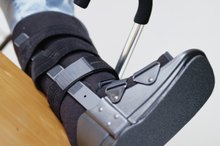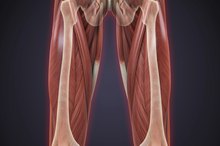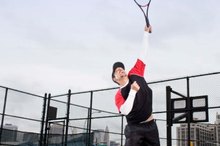Tools Required for Athletic Training
Athletic trainers are required to have at least a bachelor's degree in the field and must pass tests to become certified to work in the field. Once certified, athletic trainers work with school and professional sports teams, as well as provide rehabilitation support in clinics, hospitals and doctor's offices. The nature of the work requires certain tools that must be available for the trainers to properly perform their duties.
Orthopedic Tools
Some of the more common sports injuries are sprains and broken bones. It is important to the long-term health of the injured person to have the sprain or break immobilized as quickly as possible. As the first person who will treat these types of injuries, athletic trainers have a variety of hard splints and air splints and casts to use in setting and supporting the injured bone or soft tissue. They not only provide support but also help with pain management and keep swelling under control.
- Some of the more common sports injuries are sprains and broken bones.
- As the first person who will treat these types of injuries, athletic trainers have a variety of hard splints and air splints and casts to use in setting and supporting the injured bone or soft tissue.
Traction Supplies
Torn Tendons & Ligaments From Hyperextension
Learn More
Injuries to the spinal cord and muscles of the back and surrounding area are also common when participating in athletic endeavors. To be properly prepared to treat such injuries, athletic trainers will have ready access to lumbar and cervical traction units that can be immediately attached to provide support to the back or the pelvic region. Traction devices treat back, neck or pelvic injuries by helping to stretch out the area to ease compression problems.
Therapeutic Aids
The most common tool of the athletic trainer is the ice pack. That, combined with a heating pad, is used more than anything other tool in the trainer's bag. With most sports injuries, the initial treatment includes icing the injury to keep swelling down and allow for healing to begin. Regular icing and application of heat are done not only in treatment of injuries but to prevent them, as it is a regular practice to ice joints immediately after practices and games.
- The most common tool of the athletic trainer is the ice pack.
- Regular icing and application of heat are done not only in treatment of injuries but to prevent them, as it is a regular practice to ice joints immediately after practices and games.
Exercise Equipment
How to Heal a Sprained Wrist Quickly
Learn More
While less frequently associated with the athletic trainer, exercise equipment like stationary bikes, treadmills, elliptical trainers and balance balls are becoming more essential as time goes by. One of the important functions of the trainer is to aid rehabilitation and encourage injury prevention with regular exercise. These tools are used in rehab but can also keep athletes loose during practices or competition.
Athletic Tape
One of the key ingredients used by the athletic trainer is athletic tape. Many athletes have their ankles taped before participation to provide support that will help them avoid injuries. Tape can also be used to treat an injury and to provide additional support to other parts of the body.
Related Articles
References
Writer Bio
Kurt Johnson began writing in 1995. He has a passion for sports and has spent more than 15 years as a coach. He is a sportswriter who has been published at Front Page Sports and in the "Sacramento Union." Johnson has a Bachelor of Arts in communications from Brigham Young University.









